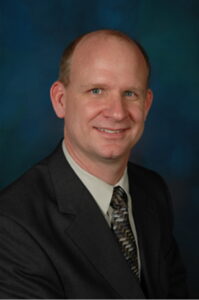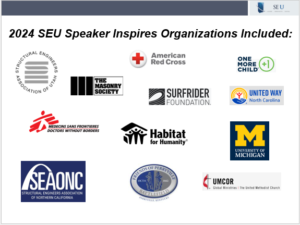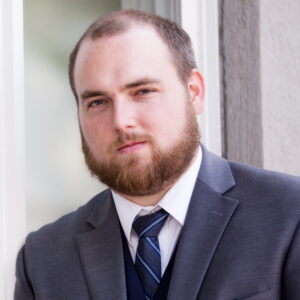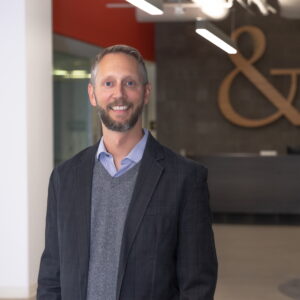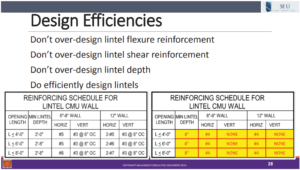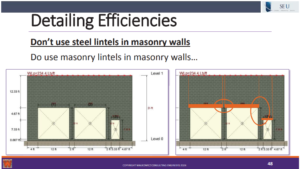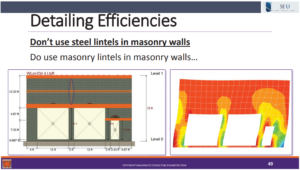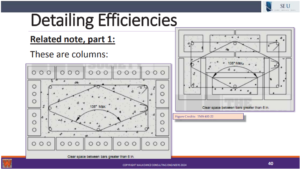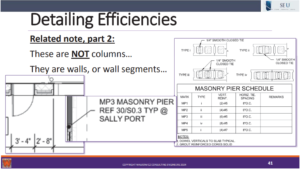In August 2024, SEU welcomed Mark Jarvinen, PE and Tom Tarcha, PE, from Simpson Strong-Tie, to present Post-Installed Adhesive Anchors into Cracked and Uncracked Masonry. Mark and Tom have designated Habitat for Humanity (https://www.habitat.org/) for our SEU Speaker Inspires donation for the month.
A proud supporter of Habitat for Humanity for more than two decades, Simpson Strong-Tie has been a national sponsor of Habitat for Humanity International since 2007, donating more than $2.5 million in cash and products. The contribution has helped support numerous Habitat houses across North America as well as U.S. and international programs. In addition, Simpson Strong-Tie employees have contributed hundreds of volunteer hours in building homes and training local Habitat affiliates along with joining the Jimmy and Rosalynn Carter Work Projects to repair and build homes affected by natural disasters.
Thank you, Mark and Tom, for helping structural engineers with your SEU session, and for your designation of Habitat for Humanity as our SEU Speaker Inspires Organization of the Month!
SEU began the SEU Speaker Inspires program in 2015 as a way to “pay it forward”, enabling our speakers to designate a charity/organization of their choice for SEU to make a donation to help improve our world.
20 Dec / 2024
“SEU Speaker Inspires” Organization of the Month: Structural Engineers Association of Utah Scholarship Fund
In July 2024, SEU welcomed Barry Arnold, PE, SE, retired from ARW Engineers, to present Temperature Effects in Steel Structures. In 2022, Barry designated Structural Engineers Association of Utah Scholarship Fund (Structural Engineers Association of Utah – Scholarships (seau.org)) for our SEU Speaker Inspires donation for the month, and he has chosen to do the same in 2024.
Barry shared, “As a student struggling to pay for tuition and books, attending classes, completing homework, maintaining a good family life, and working full-time, I remember how grateful I was to receive a scholarship. Receiving a scholarship reduced my anxiety and the pressure I felt by easing my financial burdens. I hope whoever receives this scholarship will benefit from the financial assistance as I did when I was a student.”
Thank you, Barry, for helping structural engineers with your SEU session, and for your designation of Structural Engineers Association of Utah Scholarship Fund as our SEU Speaker Inspires Organization of the Month!
SEU began the SEU Speaker Inspires program in 2015 as a way to “pay it forward”, enabling our speakers to designate a charity/organization of their choice for SEU to make a donation to help improve our world.
20 Dec / 2024
Happy Holidays from SE Solutions
|
Happy Holidays from SE Solutions! It’s the holiday season, and we would like to take this opportunity to thank our SEU clients and speakers for being a part of our SEU family during 2024. Because of your support, we have been able to make many charitable donations during the past year through our SEU Speaker Inspires program. We wish all of the structural engineering community a wonderful holiday season and we look forward to the opportunities to come in 2025!
SE Solutions began the SEU Speaker Inspires program in 2015 as a way to “pay it forward”, enabling our speakers to designate a charity/organization of their choice for SEU to make a donation to help improve our world. To read more about SEU Speaker Inspires, please visit the SEU Speaker Inspires category on the SEU blog. We want to thank our speakers throughout the year who participated in this program, and we look forward to future donations in 2025. Warm wishes for a wonderful holiday season!
|
Structural systems using open-web steel joists are popular due to their cost effectiveness, flexibility, and ease of installation. Because these systems have high strength-to-weight ratios, human-induced vibration often controls the member sizes, especially when traditional seats are used. One significant improvement is to change from traditional seats to flush-framed connections.
In the November 2024 SEU Session, Brad Davis, Ph.D., S.E., from Davis Structural Engineering, presented Vibration Analysis of Steel Joists / Concrete Floors. Brad reviewed the AISC Design Guide 11 and SJI Technical Digest 5 methods for evaluating floors for vibration and discussed recent innovations in open-web steel joist floor systems. He noted key improvements in the vibration evaluation methods and discussed research efforts regarding hybrid mass-timber / open-web steel joist systems.
Flush framed connections of steel joists to girders may not be a new concept, however, using this connection for its vibration mitigation benefits is a novel approach to vibration design. To hear Brad discuss the geometry and advantages of this type of joist connection, click below to watch this short video:
When using traditional joist seats, the joists cannot be considered continuous with the girder. Using flush framed connections may allow for a shallower structural system, permit the system to act compositely, and increase the continuity factor and the Cg factor in the girder effective panel weight calculation. All of these changes benefit the overall vibration performance of the structural framing system. Flush framed connections and the equations Brad discussed are covered in AISC Design Guide 11 Section 4.1.2 and SJIs Technical Digest 5 Chapter 3. Using these connections may be an option to reduce vibrations in your future design projects.
In December 2024, SEU welcomed Andrew Walters, PE, from American Engineering Testing, to present Guide to Understanding a Project Geotechnical Report. Andy designated Dr. Tom Nelson Civil Engineering Memorial Scholarship at the University of Wisconsin – Platteville (Civil engineering scholarship established in memory of Dr. Tom Nelson | UW-Platteville News) for our SEU Speaker Inspires donation for the month.
Andy shared “As an alum of the University of Wisconsin – Platteville and former student of Dr. Tom Nelson, I selected the Dr. Tom Nelson Civil Engineering Memorial Scholarship because of the positive impact Dr. Nelson left on me and the ‘get your hands dirty’ way the Civil Engineering Department at UW-Platteville shaped the beginning of my career and continues to produce outstanding civil engineers.”
Thank you, Andy, for helping structural engineers with your SEU session, and for your designation of Dr. Tom Nelson Civil Engineering Memorial Scholarship at the University of Wisconsin – Platteville as our SEU Speaker Inspires Organization of the Month!
SE University began the SEU Speaker Inspires program in 2015 as a way to “pay it forward”, enabling our speakers to designate a charity/organization of their choice for SE University to make a donation to help improve our world.
25 Nov / 2024
Happy Thanksgiving from SE Solutions!
As we enter this Thanksgiving week, we would like to take this opportunity to thank our SE Solutions community and wish everyone a joyous holiday. SE Solutions and SEU are thankful to our clients and speakers who have made it possible for us to contribute to many charitable organizations during the past year through our SEU Speaker Inspires program and to support hurricane recovery efforts in 2024.
In June 2024, SEU welcomed Josh Canova, PE, from New Millenium, and Gerald McKenzie, PE, from Vulcraft, to present Concentrated and Non-Uniform Loading on Steel Deck. Josh and Gerald have designated One More Child (https://onemorechild.org/) for our SEU Speaker Inspires donation for the month.
Josh shared, “As a husband and father who is not only blessed with a family but blessed to be able to provide for my family, I wanted to choose an organization that supports and cares for those who have had a tougher go at things and find themselves in difficult situations. One More Child is a faith-based organization that serves the most vulnerable in our society by supporting children in need, combatting human trafficking, and providing support for single moms or families in need.”
Thank you, Josh and Gerald, for helping structural engineers with your SEU session, and for your designation of One More Child as our SEU Speaker Inspires Organization of the Month!
SEU began the SEU Speaker Inspires program in 2015 as a way to “pay it forward”, enabling our speakers to designate a charity/organization of their choice for SEU to make a donation to help improve our world.
In May 2024, SEU welcomed Matt Timmers, SE, from John A. Martin & Associates, to present Mass Timber Structural Design. Matt has designated Surfrider Foundation (surfrider.org) for our SEU Speaker Inspires donation for the month.
Matt shared, “The Surfrider Foundation is best known for their advocacy for ocean health, a cause near and dear to my heart and central to global climate change issues. Their mission includes commitment to broad global sustainability goals, including the reduction of plastic waste, ensuring equitable access to coastline, and protecting the health of both coastal and inland water systems. For all these reasons I support their mission and chose them as my SEU Speaker Inspire organization.”
Thank you, Matt, for helping structural engineers with your SEU session, and for your designation of Surfrider Foundation as our SEU Speaker Inspires Organization of the Month!
SEU began the SEU Speaker Inspires program in 2015 as a way to “pay it forward”, enabling our speakers to designate a charity/organization of their choice for SEU to make a donation to help improve our world.
Masonry wall openings are a common location for diagonal cracks which can result from improperly detailed lintels. Steel lintels can be properly detailed to span openings in masonry walls, but would a masonry lintel be more efficient?
In the September 2024 SEU session, Scott Walkowicz, PE, from Walkowicz Consulting Engineers, presented Masonry Design and Detailing: Using Your Owner’s Money Wisely. Scott discussed the structural performance benefits and building improvements achieved through the use of masonry, as both a structure and an outer envelope. He identified ways to reduce cost and minimize material waste in masonry design and detailing. He also examined masonry details to create functional, durable, and constructable masonry assemblies.
Scott recommends using masonry lintels in masonry walls, as opposed to steel lintels. Steel lintels can cause many issues in masonry walls and are rarely needed. Differential movement is among the most problematic issues when using steel lintels in masonry walls. Also, in the event the steel lintel is accidentally or erroneously restrained, very large forces can develop in the steel and cause significant cracking in the masonry wall. Masonry lintels provide a more cohesive design and can be designed to resist significant forces. As you can see below, an efficient masonry lintel design requires minimal reinforcement to span short distances. When necessary, reinforcement can be added to increase the capacity of masonry lintels carrying significant forces. However, engineers should consider their typical lintel schedules to be sure efficient reinforcing is specified to minimize the overall project cost.
Masonry lintels also contribute to stronger walls. As you can see below, several control joints are necessary in the wall using steel lintels. These joints reduce the capacity of the wall, increase the chance of differential movement between the lintel and the wall, and increase the chance of cracks in the masonry. Replacing the steel lintels with masonry bond beams and lintels create strong wall action, as shown in the finite element model on the slide below. This wall is more efficient and results in a better product.
As a best practice, engineers should eliminate steel lintel schedules as typical details on their masonry projects and replace them with an efficient typical masonry lintel schedule. When required for heavy loads, additional masonry lintel details are capable of carrying significant loads and should be designed for specific loading conditions. Efficient masonry lintels used throughout a masonry project will reduce the overall cost for the owner and minimize problems typically created by steel lintels.
The cost of masonry construction can vary widely, in part due to inefficient designs which can drive up the labor costs on a structural project. There are many strategies which can reduce unnecessary costs in masonry construction, but are you aware of common inefficiencies engineers specify which are responsible for some of these added costs?
In the September 2024 SEU session, Scott Walkowicz, PE, from Walkowicz Consulting Engineers, presented Masonry Design and Detailing: Using Your Owner’s Money Wisely. Scott discussed the structural performance benefits and building improvements achieved through the use of masonry, as both a structure and an outer envelope. He identified ways to reduce cost and minimize material waste in masonry design and detailing. He also examined masonry details to create functional, durable, and constructable masonry assemblies.
Scott covered a number of useful tips to reduce the cost of masonry construction. One common inefficiency which drives up the cost of masonry construction is the unnecessary use of confinement ties in masonry walls or pilasters. Scott noted that confinement ties are only required by code in masonry columns and wall segments in which the primary steel is required to resist compressive loads. Many times typical masonry details are shown to include confinement ties in wall segments (commonly called piers) and pilasters when engineers assume that piers and pilasters are columns within a wall. However, pilasters are considered thickened walls and not columns and wall segments are simply wall segments. Thus, confining ties would only be required when the primary reinforcement is analytically needed to resist compression forces. As you can see in the slides below, Scott notes common details for what would and would not qualify as columns in masonry construction.
Confinement ties do add to the material costs of a project, but especially drive up the labor costs due to the extra time spent placing and tying off this additional reinforcement. In most cases, confinement ties are not needed in walls or pilasters, unless the engineers has included them in their analysis to resist axial loads. Engineers should often review their typical masonry details to be sure they are practical and efficient, and meet code requirements. Typical details which include unnecessary reinforcement should be revised to reduce project costs.



